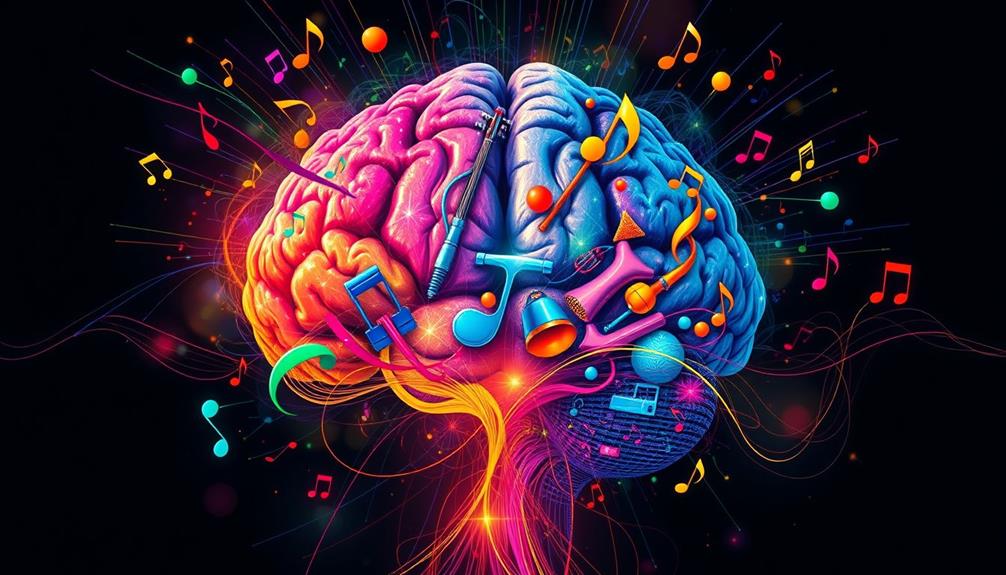Music therapy can greatly enhance the lives of Alzheimer's and dementia patients. It boosts cognitive function, evoking memories and improving mood through familiar tunes. You'll find personalized music programs can lead to better memory retention and emotional connections, reducing agitation and anxiety. These sessions also foster stronger bonds between patients and caregivers. Incorporating music into daily routines can create a comforting atmosphere that eases stress and improves communication. By understanding preferences and utilizing tailored music selections, you can create meaningful experiences. Explore further to understand how to implement effective music therapy interventions for ideal patient engagement and well-being.
Key Takeaways
- Music therapy enhances cognitive function, improving memory retention and language abilities in Alzheimer's and dementia patients.
- Personalized music triggers emotional connections, reducing agitation and anxiety while enhancing patient engagement.
- Familiar melodies serve as powerful mnemonic devices, helping patients access lost memories and improve mood.
- Incorporating music into routines alleviates caregiver stress and fosters emotional well-being for both patients and caregivers.
- Collaborating with trained music therapists ensures tailored interventions that optimize the benefits of music therapy.
Overview of Alzheimer's Disease
Alzheimer's disease (AD) is a complex condition that accounts for 60-80% of all dementia cases, affecting around 55 million people worldwide. This number is projected to reach 153 million by 2050, highlighting the urgency of understanding this debilitating disease.
AD progresses through a preclinical phase lasting 15-20 years, followed by mild cognitive impairment (MCI) for 3-6 years before dementia symptoms appear. Incorporating therapeutic practices, such as yoga for back pain management, can potentially improve overall well-being during the progression of the disease.
As the disease advances, you might notice cognitive decline and memory loss, which can manifest as language difficulties and behavioral changes. Notably, older patients often exhibit a "positivity effect," recalling positive memories despite their overall cognitive impairment.
These changes are linked to key neuropathological features of AD, such as amyloid-β plaques and tau protein tangles, which lead to significant brain atrophy in regions like the posterior cingulate cortex and precuneus.
While the psychological symptoms of AD can be distressing, music therapy emerges as a promising intervention. It may help restore a sense of identity by enhancing autobiographical memory recall, improving mood, and reducing anxiety.
Additionally, it fosters emotional connections when verbal communication becomes increasingly challenging, making it an essential tool in managing Alzheimer's disease.
Benefits of Music Therapy
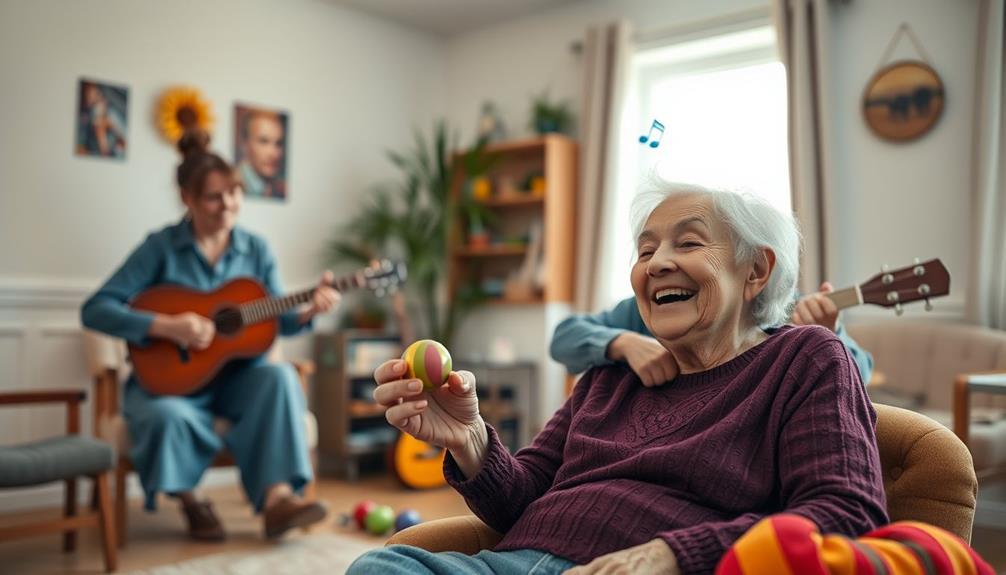
Music therapy offers significant benefits for individuals with Alzheimer's and dementia, especially in enhancing cognitive function. Some of the benefits of music therapy for individuals with Alzheimer’s and dementia include improving their mood and reducing symptoms of anxiety and depression. Additionally, it can help to stimulate memories and improve communication skills. Overall, music therapy can have a profound impact on the quality of life for those living with these conditions.
Research has shown that engaging with music can also aid in altitude acclimatization to enhance fat burning, leading to improved energy levels and motivation.
You'll find that familiar tunes can strengthen emotional connections and improve communication with caregivers, fostering a sense of comfort.
Additionally, it can help reduce stress and anxiety for both patients and those caring for them, improving overall well-being.
Cognitive Function Enhancement
Research shows that engaging with music therapy can lead to significant cognitive function enhancements for individuals with dementia. For dementia patients, passive music interventions, like simply listening to familiar tunes, often prove more effective than active methods such as singing and dancing.
These interventions can trigger long-term memory, which remains surprisingly intact even in the later stages of Alzheimer's disease. Additionally, the use of music in therapy can be compared to AI in music creation, as both explore the intersection of technology and emotional engagement.
When you participate in a personalized music program, you may see as much as a 50% improvement in cognitive-function test scores during therapy sessions. This highlights the importance of selecting music that resonates personally with you.
Moreover, the therapeutic use of music stimulates neuroplasticity, helping to forge new neural connections that enhance cognitive functions and emotional responses.
Emotional Connection Strengthening
When engaging with music therapy, you may find that emotional connections deepen in surprising ways. For dementia patients, personalized music can trigger Music-Evoked Autobiographical Memories (MEAMs), allowing them to recall cherished life experiences through familiar melodies. This powerful recall not only enhances emotional language but also fosters meaningful engagement, making the therapeutic experience more impactful.
Research indicates that similar to how cats recognize their owner's voice, music can evoke strong emotional responses that resonate with patients, creating a unique bond during therapy sessions. This connection can be essential in improving their overall well-being, as seen in cat emotional attachment.
As you participate in music therapy, you could notice significant reductions in agitation and anxiety. This calming effect strengthens communication and bonding between you and the patient, leading to improved interactions. The emotional responses elicited by music can stimulate dopamine release, enhancing pleasure and mood.
This boost in emotional well-being often translates into joyful behaviors, such as spontaneous singing and dancing, which further solidify your emotional connections.
Through music therapy, you're not just providing therapeutic support; you're creating an environment where emotional bonds flourish. The shared experiences during these sessions can lead to deeper relationships, enriching both your lives.
Caregiver Stress Reduction
Caregivers often experience high levels of stress and emotional strain, but engaging in music therapy can provide considerable relief. This powerful tool not only enhances your mood but also fosters a strong emotional connection with your loved one. Through music, you can create joyful moments that brighten your day and theirs.
Additionally, music therapy can help address symptoms of mental health support that may arise during caregiving, such as anxiety and depression, further enhancing your overall well-being.
- Feel the weight lift as you listen to calming melodies.
- Watch your patient's face light up with spontaneous singing.
- Share laughter and dance together, creating cherished memories.
- Experience deeper engagement, transforming stressful moments into peaceful interactions.
Incorporating music into daily routines serves as an effective coping mechanism for you as a caregiver. It helps regulate your mood and can even improve your sleep quality by increasing melatonin secretion.
Studies show that engaging with music can lead to a 50% improvement in patient engagement, considerably reducing your anxiety and stress levels. By nurturing a shared love for music, you not only enhance your emotional bond but also cultivate a supportive environment, making the caregiving journey more manageable and fulfilling while alleviating the burdens of dementia care.
Mechanisms of Music Therapy

Music therapy (MT) employs various mechanisms that greatly benefit individuals with Alzheimer's and dementia. One of the key aspects of MT is its ability to enhance cognitive function through both active and receptive methods, such as playing instruments and listening to music. This non-pharmacological intervention not only improves memory retention but also boosts language abilities, leading to better verbal fluency and a reduction in psychiatric symptoms.
Additionally, the integration of technology in music therapy may optimize these benefits, emphasizing the importance of AI advancements in health.
The neurobiological mechanisms behind music therapy play a vital role in its effectiveness. For instance, music stimulates dopamine release, enhancing feelings of pleasure and reward. Additionally, it activates the anterior hippocampal formation, potentially stimulating neurogenesis and slowing down hippocampal atrophy.
Moreover, personalized music programs can greatly alleviate depression, anxiety, and agitation in Alzheimer's disease patients. Familiar melodies often evoke Music-Evoked Autobiographical Memories (MEAMs), linking emotional connections to past experiences, which can be incredibly therapeutic.
Music and Memory Connection
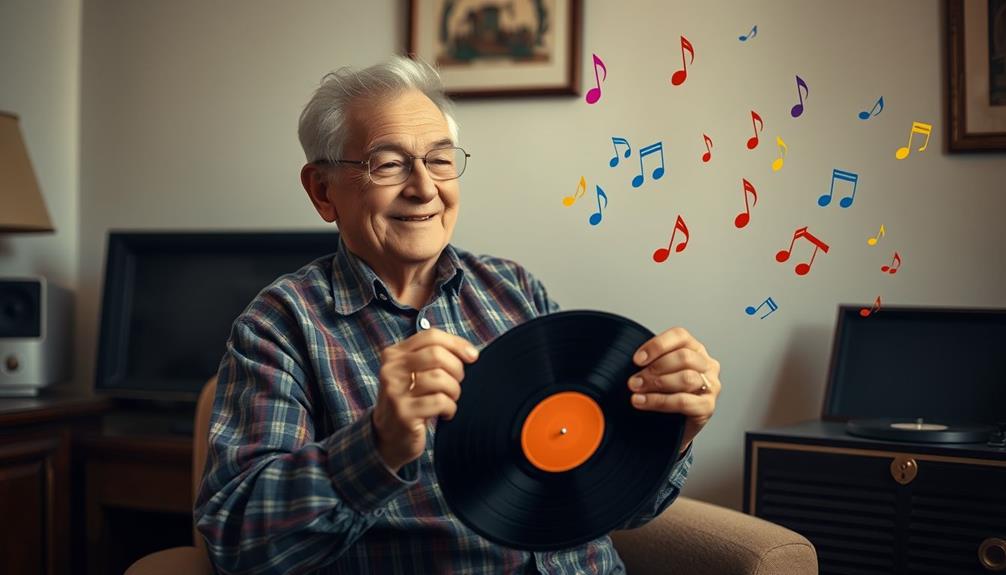
There's something truly remarkable about how melodies can reveal memories, especially for those facing Alzheimer's and dementia. Music acts as a powerful mnemonic device, tapping into emotional connections through familiar melodies. It can evoke memories that seem lost, enhancing memory retrieval and providing a glimpse into the past.
Additionally, the soothing effects of certain teas, like Rooibos tea, known for its calming properties, can complement the therapeutic experience by promoting relaxation during music therapy sessions.
- The sound of a loved one's favorite song
- The rhythm of a childhood lullaby
- The tune of a classic film score
- The melody of a wedding anthem
Research shows that music conditions lead to faster and more emotionally impactful memory retrieval compared to silence. Despite cognitive decline, many Alzheimer's patients retain the ability to recognize and even sing along to melodies. This connection to music can improve mood, reduce anxiety, and alleviate agitation, creating a therapeutic experience for patients.
Moreover, self-selected music deepens emotional language during memory recall, fostering stronger bonds between patients and caregivers. By incorporating familiar tunes into care routines, you can harness the power of music to access precious memories and enhance emotional well-being, transforming moments of confusion into opportunities for connection and joy.
Selecting Music for Patients
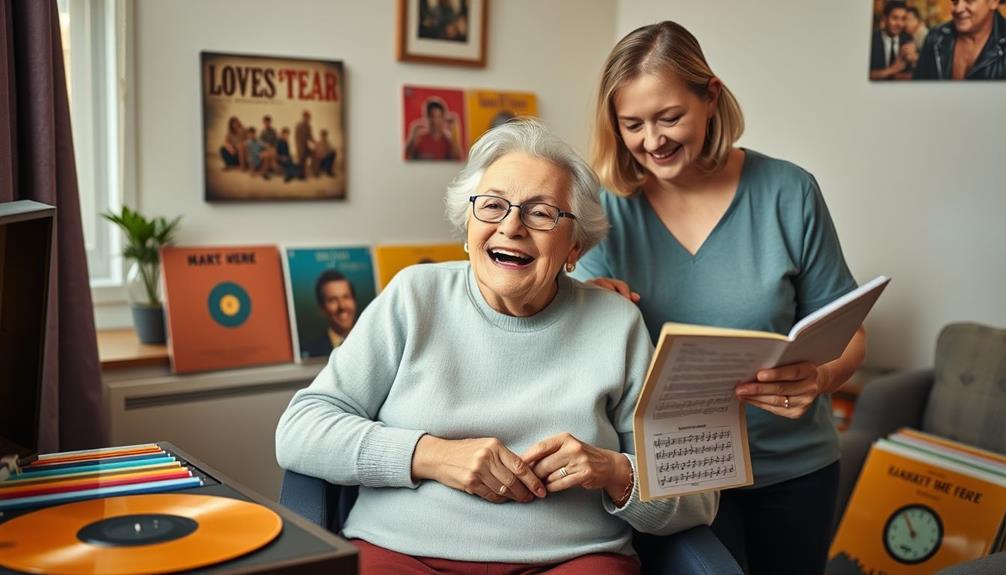
When selecting music for patients, it's essential to take into account their personal preferences and the emotional connections they've with certain songs.
Research indicates that astrological compatibility and its effects on attraction can also extend to the music one enjoys, influencing emotional responses.
You'll want to control the volume to create a comfortable listening environment and align the music with the patient's emotional state for the best therapeutic effects.
Personal Music Preferences
Selecting music that resonates with a patient's personal history can greatly enhance their emotional connection and memory recall. For individuals with Alzheimer's or dementia, the right music can evoke powerful Music-Evoked Autobiographical Memories, leading to improved cognitive engagement.
Incorporating elements such as soothing scents from essential oils for relaxation can further enhance the overall experience. To effectively select music, consider the following:
- Songs from their youth, like classic rock or jazz hits
- Melodies associated with significant life events, such as weddings or holidays
- Calming tunes to soothe agitation or distress
- Upbeat tracks that lift their spirits during moments of sadness
Observing patient reactions to various genres will help you identify their personal music preferences. This allows for personalized music interventions that cater to their emotional state.
For instance, during moments of agitation, soothing melodies can provide comfort, while lively tracks might encourage a sense of joy. By creating an immersive listening experience with uninterrupted music sources, you minimize distractions and foster deeper connections.
Ultimately, this tailored approach not only enhances emotional connections but also promotes meaningful memory recall, improving the well-being of those struggling with Alzheimer's and dementia.
Volume and Environment Considerations
Creating the right environment for music therapy can greatly boost its effectiveness for individuals with Alzheimer's and dementia. Start by selecting a comfortable volume level for the music. Too loud can overwhelm, while too soft may not engage. A well-regulated volume guarantees a pleasant listening experience, promoting the therapeutic effects of the music.
Incorporating elements of cottagecore design, such as natural materials and soft colors, can further contribute to a calming atmosphere that supports emotional well-being.
Next, choose uninterrupted music sources to avoid distractions from commercials, keeping the atmosphere soothing and focused. Minimize competing noises in the environment to create that calming atmosphere crucial for dementia patients. This allows them to concentrate on the music without sensory overload.
Consider the emotional state of the individual when planning music sessions. Aligning music selections with their feelings can optimize engagement, whether you aim to uplift their mood or promote tranquility. Incorporating movement, like clapping or dancing, can further enhance their emotional state and reduce agitation, making the experience more interactive.
Ultimately, the right volume and environment are essential for fostering effective music therapy. By paying attention to these details, you can greatly improve the quality of the listening experience and enhance the overall impact of the therapy on their well-being.
Timing and Emotional Alignment
Timing and emotional alignment are vital to effectively engaging individuals with Alzheimer's and dementia through music therapy. By selecting familiar music that resonates with their emotional state, you can enhance their responsiveness and overall engagement during music sessions.
Pay attention to how different tunes affect their moods, and tailor your choices accordingly.
- Tranquil melodies to soothe agitation and promote relaxation
- Upbeat rhythms that spark joy and encourage movement
- Nostalgic songs evoking cherished memories and connections
- Calming harmonies to ease frustration and create a peaceful atmosphere
Choosing the right timing is just as important as the music itself. Observe your loved one's emotional state and select music that aligns with their current mood.
Additionally, maintaining appropriate volume levels guarantees comfort, preventing sensory overload while enhancing the therapeutic experience.
By understanding their preferences and being mindful of their reactions, you can create a more effective music therapy environment.
With thoughtful selection and timing, you can transform music sessions into powerful tools for emotional support and connection, allowing individuals with Alzheimer's and dementia to engage more fully with the world around them.
Implementing Music Interventions
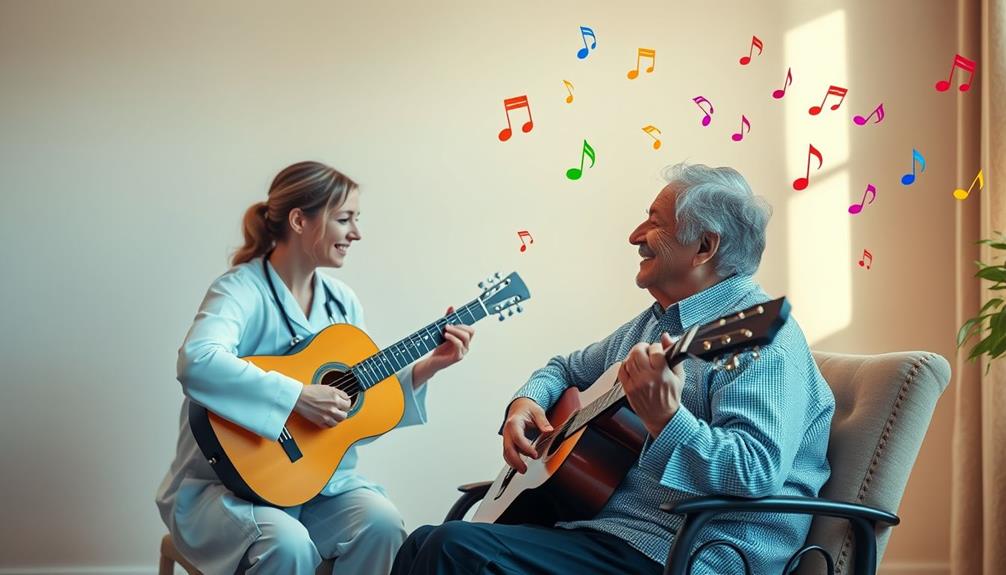
Implementing effective music interventions for individuals with Alzheimer's and dementia requires a thoughtful approach that considers their unique preferences and needs. Collaborating with trained music therapists can help create tailored music therapy sessions that enhance engagement and emotional response.
Utilizing familiar tunes from the individual's youth can evoke powerful memories and improve mood, even for late-stage dementia patients. By observing and documenting their reactions to different types of music, you can identify preferred genres for personalized playlists that foster meaningful experiences.
Establishing a consistent routine for daily music engagement is essential. Align music sessions with the individual's emotional state to maximize effectiveness and comfort. Additionally, integrating music as a calming tool during moments of agitation can greatly reduce anxiety and improve caregiver communication.
Here's a simple framework to guide your music interventions:
| Intervention Type | Purpose | Example |
|---|---|---|
| Familiar Tunes | Evoke memories | Songs from their youth |
| Personalized Playlists | Enhance engagement | Custom playlists |
| Daily Music Sessions | Routine and comfort | Scheduled listening times |
Impact on Caregivers

Music therapy not only benefits individuals with Alzheimer's and dementia but also greatly impacts their caregivers. As a caregiver, you might notice significant improvements in your emotional well-being when engaging in music activities with your loved one. Music can help reduce agitation and anxiety for both parties, creating a soothing environment.
Imagine the joy of:
- Spontaneous singing sessions that ignite laughter
- Dancing together, feeling the rhythm of connection
- Heartwarming conversations sparked by familiar tunes
- A sense of community through shared musical events
These shared musical moments enhance social communication, strengthening your bond with Alzheimer's patients. You may even experience better mood regulation, as listening to music can increase melatonin secretion, improving your sleep quality. This reduction in caregiver burnout is essential for maintaining your overall health and well-being.
Moreover, community involvement in music activities uplifts spirits, providing you with a support network. You'll find that these moments not only foster joy but also create a sense of belonging, enriching your caregiving journey.
Embracing music therapy can transform both your life and that of the person you care for, making each day a little brighter.
Community Resources and Support
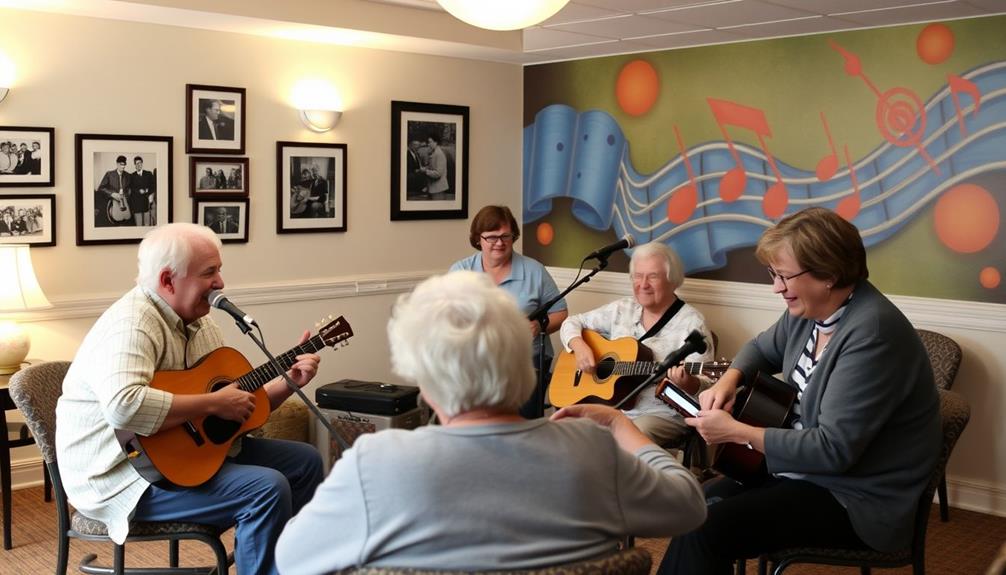
Engaging in music therapy can lead to a stronger sense of community and the discovery of valuable resources to support your caregiving journey. As a caregiver, taking advantage of community support can make a significant difference in managing behavioral symptoms and enhancing the quality of life for both you and your loved one.
Here are some key resources you can explore:
| Resource | Description |
|---|---|
| Alzheimer's Association | Offers local chapters with educational programs and support groups. |
| ALZNavigator | An online tool providing guidance on care options and support services. |
| ALZConnected | A free online community for caregivers to share experiences and advice. |
| 24/7 Helpline | Call 800.272.3900 for immediate assistance and support. |
| Donations | Contribute to fund essential resources and advancements in Alzheimer's care. |
Future Research Directions

Numerous opportunities exist for advancing research in music therapy for Alzheimer's and dementia. To enhance therapeutic efficacy and consistency, you'll want to focus on establishing standardized protocols tailored to the various stages of dementia.
Additionally, consider the following directions for future research:
- Longitudinal studies to assess the sustained effects of music therapy on cognitive function and emotional well-being.
- Investigating neurobiological mechanisms to understand how music therapy may mitigate neurodegeneration in Alzheimer's patients.
- Incorporating physiological measurements, such as brain imaging and biomarkers, to explore the relationship between music therapy and neuroplasticity.
- Utilizing larger sample sizes and diverse methodologies to improve the reliability and generalizability of findings in dementia care.
Frequently Asked Questions
What Music Therapy Activities Are Good for Alzheimer's Patients?
You can try listening to familiar songs, encouraging movement through clapping or dancing, creating personalized playlists, and organizing group activities. These enhance engagement, boost mood, and foster connections while respecting individual dignity and promoting self-expression.
What Kind of Music Is Best for Alzheimer's Patients?
When it comes to music, you can't judge a book by its cover. Familiar tunes from your past evoke emotions and memories, while upbeat songs lift your spirits. Choose what resonates with you for the best experience.
What Are the Disadvantages of Music Therapy for Dementia Patients?
You might find that music therapy has some disadvantages, like inconsistent responses among patients, limited long-term effectiveness, high variability in study outcomes, and challenges in accessibility due to the need for trained therapists and resources.
What Is One Reason Music Therapy Can Be Effective for Residents With Alzheimer's Disease?
Like a lighthouse guiding ships, music therapy can illuminate memories, allowing you to connect with your past. It taps into emotions, fostering communication and reducing agitation, creating a comforting space for residents traversing their journey.
Conclusion
Incorporating music therapy into the care of Alzheimer's and dementia patients can truly be a game changer. As you witness the joy and connection that familiar tunes bring, you'll realize that music acts as a bridge to their memories. It not only enhances their well-being but also lightens the load for caregivers. By embracing this powerful tool, you're not just enriching lives; you're helping to create moments of clarity and connection that can last a lifetime.





